What's new

What might the future working world look like for young adults with disabilities?
An IWH research team has examined how working life could change in Canada over the next seven years and what the implications might be for young adults with a disability. Using strategic foresight methods, the team created three future scenarios that are designed to provoke discussion about the policies needed now to ensure an inclusive future for people with disabilities.
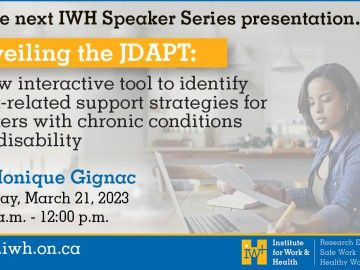
IWH unveiling tool to help workers with chronic conditions find job-tailored supports
An evidence-based tool from the Institute for Work & Health (IWH) helps workers with chronic conditions learn about customized job supports and modifications that can help them continue to work safely, comfortably and productively. On March 21 at an IWH Speaker Series webinar, Senior Scientist Dr. Monique Gignac unveils the new Job Demands and Accommodation Planning Tool (JDAPT) developed by the Accommodating and Communicating about Episodic Disabilities (ACED) partnership. She describes the tool, how it works and the studies conducted to back it up.
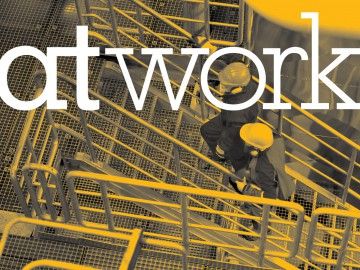
The Winter issue of At Work is out!
In the issue, read about:
- A new research program on AI, work and health
- IWH's OHS Vulnerability Measure's high ranking in a study of leading indicators
- The inclusion of the 'Seven Principles' in Workers Compensation Board of Manitoba's updated return-to-work workshop
And more...
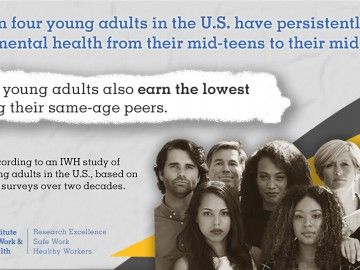
New study looks at mental health and earnings of U.S. young adults over 20-year span
A study based on a large, nationally representative sample of 8,000 individuals in the U.S. looked at their earnings and mental health over 20 years. It found those with poor mental health are also the ones with the lowest earnings.

What research can do: Manitoba’s WCB uses IWH research in update of RTW workshop
The Workers Compensation Board of Manitoba recently updated its Return to Work Basics workshop, and the Institute’s ‘Seven Principles for Successful Return to Work’ is a key part of it. In our latest impact case study, summarized here, Manitoba WCB’s return-to-work manager shares her thoughts on the value of research.

IWH’s OHS Vulnerability Measure leads pack in study of leading indicator tools
In an Australian study of five occupational health and safety (OHS) leading indicator tools around the world, a measure developed by the Institute has come out ahead for its ability to pick up workers’ risk of reporting a physical injury or a near-miss at work. The OHS Vulnerability Measure is now one of two tools recommended by the study team for use by the local workers’ compensation authority.

IWH Speaker Series: Findings from systematic review on racial and ethnic inequities in RTW
Studies to date have found evidence of racial inequities in work-related injuries and illnesses, but what about in return to work (RTW)? On January 17, in the first IWH Speaker Series presentation of 2023, an IWH team shares findings from a systematic review on racial inequities in the reintegration of injured or ill workers. The team will also discuss opportunities to address obstacles faced by workers of colour in RTW and provide recommendations for future research.
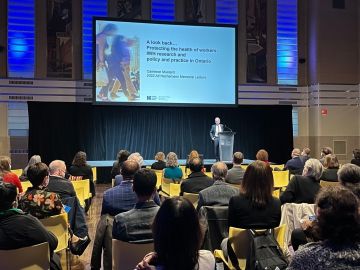
Twenty-year look-back by former IWH president finds bright spots in prevention system
On November 3, the Alf Nachemson Memorial Lecture returned after a three-year hiatus with a look-back by Dr. Cameron Mustard. The former IWH president shared five key learnings gleaned over his 20 years at the helm of the Institute.

Our KTE team is hiring!
Join the team that’s charged with getting IWH research out to users and stakeholders. Check out our opportunities page for details on two full-time, permanent postings: one for Knowledge Transfer & Exchange (KTE) Associate and one for Visual-Digital Communications Associate. The deadline to apply is December 22.
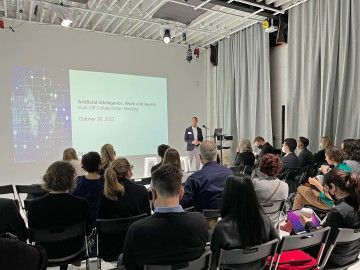
IWH launches research program on AI and workplace safety, inequities
Uses of artificial intelligence (AI) are all around us but, until now, few researchers have examined the impact of AI through the lens of worker inequities and worker health and safety. In October, a team led by IWH Scientist Dr. Arif Jetha kicked off a new research program at IWH on these topics.
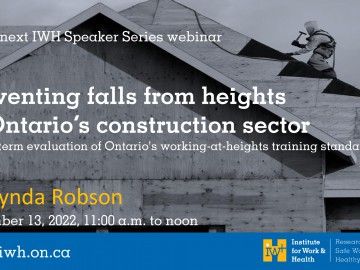
IWH Speaker Series: Effectiveness of mandatory training standard to prevent falls from heights
In 2015, the Ontario government implemented a working-at-heights (WAH) training standard to ramp up fall prevention efforts. An IWH study team, led by IWH Scientist Dr. Lynda Robson, has now gathered two additional years of data on the effectiveness of this training requirement. Find out what the team learned at our next IWH Speaker Series webinar, taking place on December 13.
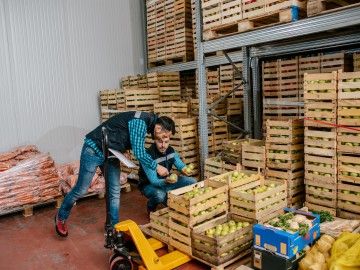
Employers struggle to provide newcomers with OHS training and support, IWH study finds
Employers are responsible for providing occupational health and safety (OHS) training and support to keep workers safe. When it comes to workers who are new to Canada, however, workplaces face particular challenges following through on this responsibility.

IWH Updates - Fall 2022
IWH thanks former Board of Director members and welcomes new ones ~ IWH’s latest annual report highlights research on both emerging and longstanding issues

What research can do: Sector safety group helps members measure OHS with IWH safety culture tool
When the Saskatchewan Construction Safety Association (SCSA) set out looking for a tool to measure the safety culture of its member firms, it turned to the Institute’s Organizational Performance Metric (IWH-OPM). The SCSA is asking members to assess their safety culture in multiple waves. And to do that, it needs a measure that’s easy to use.
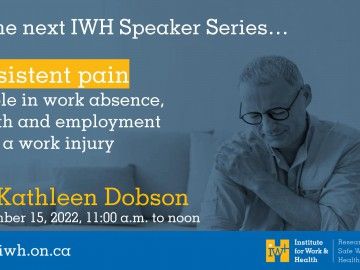
IWH Speaker Series webinar explores persistent pain after work injury
How common is it for injured workers to continue experiencing pain after a work injury? In the next IWH Speaker Series, on November 15, Dr. Kathleen Dobson shares findings from a study conducted with workers’ compensation claimants in Ontario.

Why older workers are reluctant to disclose their support needs
The aging of the working population may be a big factor behind the labour shortages being felt across the country, but if you ask older workers, many would say they’re in no hurry to retire. However, they do have support needs that they may not divulge. In a new study, Institute for Work & Health (IWH) Senior Scientist Dr. Monique Gignac explores the risks of disclosure older workers perceive, and suggests ways workplaces can support and retain these employees despite the communication barriers.

On November 3, join us at the Nachemson Memorial Lecture
After retiring in January 2022 and capping a 20-year run at the helm of the Institute, former IWH President Dr. Cameron Mustard returns to deliver the 2022 Alf Nachemson Memorial Lecture. On November 3, join us to hear Mustard reflect on the Institute’s research over two decades, and its impact on practices and policies in the protection of Ontario workers from work-related injury, illness and disability. The lecture and reception are open and free to all.
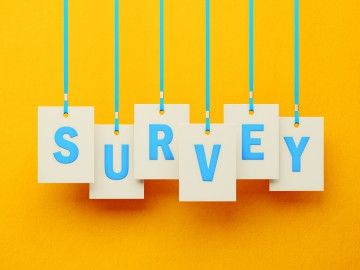
Please take our short survey
The Institute for Work & Health needs your help. In 2023, we are renewing our strategic plan and research priorities. We want to hear your thoughts on what IWH does, the usefulness of our research, and where you think we should focus our research over the next five years. Please take this short, anonymous survey, which closes October 31.

Now available: New resource on return to work in policing
A resource is now available on the return-to-work (RTW) challenges in policing and ways to address them. As outlined by Dr. Dwayne Van Eerd in an IWH Speaker Series webinar on October 18, this four-page resource describes the challenges along three key themes—accommodation, communication and trust-building. This resource is intended for members, both sworn and civilian, in Ontario’s police services.
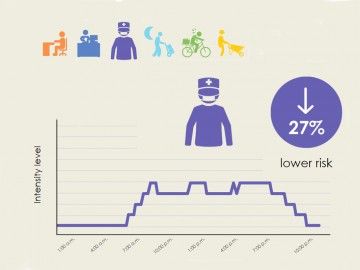
How Canadian workers move in a day, and what that means for their heart health
Canadian workers fall into one of six groups in the way they move throughout the day. Which have the best heart health? A new infographic describes the daily movement patterns of the six groups and compares their 10-year risks of heart disease, based on recent study findings.

Majority of workers still experience pain a year after injury: study
A high proportion of injured workers in Ontario experience persistent pain for well over a year after their work-related injury. In a study of workers’ compensation lost-time claimants, an Institute for Work & Health (IWH) team found 70 per cent of workers experience some level of pain 18 months post-injury.

IWH Speaker Series webinar explores return-to-work challenges in policing
What challenges do members of police services face after a work injury? In an IWH Speaker Series on October 18, IWH Scientist Dr. Dwayne Van Eerd shares findings from a recent study on return to work in Ontario police services. He also highlights suggestions that emerged from the data on ways to improve the return-to-work process.

Webinar now available: Supporting older workers to stay at work
Many older workers don't want to retire, but they may have support needs they don't want to disclose. How do employers provide these workers support and help them stay on the job? On September 20, at the first IWH Speaker Series webinar of the season, Senior Scientist Dr. Monique Gignac shared insights from a recent study. The webinar is now available to watch on-demand.

New initiative aims to ‘skill up’ employers on inclusion of persons with disabilities
Efforts to date to improve the employment of persons with disabilities have focused on making them job-ready. A new initiative, a joint project at the Institute for Work & Health (IWH) and McMaster University, now sets out to flip that approach on its head. It aims to “skill up” workplaces instead.

Join study on future challenges for young workers with disabilities
An ongoing study at the Institute for Work & Health identified six key challenges that young people with disabilities are expected to face in the future of work. In a series of short videos, we describe six major trends that are expected to shape employment for vulnerable workers over the next 10 years—and the program or policies that have the potential to protect these workers. Watch the first video and take part in the study.
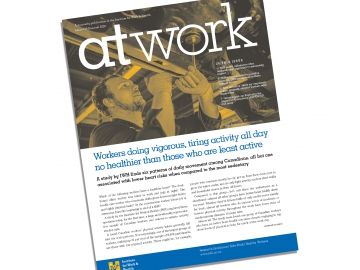
At Work Summer 2022 is out!
The Summer 2022 issue of At Work is out. If you did not get it in your inbox, make sure to subscribe.

IWH model influences other research orgs’ approach to measuring impact
Research organizations in the field of work and health share a common challenge: how to assess the difference they make. IWH’s Research Impact Model was developed in 2010 to guide Institute thinking about, and documentation of, its impact. The model has resonated with other organizations around the world doing similar research. As told in a new impact case study, summarized here, the model has made a difference in how several research institutes assess the impact of their work and shape their knowledge transfer and exchange strategies.

Study examines links between job conditions and rheumatic disease symptoms
Can work and labour market conditions be linked to worsened rheumatic symptoms in young adults with the disease? Most studies aimed at removing work barriers for young people with rheumatic diseases have focused on clinical care—not on adapting working conditions. An IWH study examined how job security and work limitations are linked with pain, fatigue and other rheumatic disease symptoms.

How does real-time online training compare with face-to-face formats?
When much of work-related training went virtual during the COVID-19 pandemic, providers of occupational health and safety training naturally began asking questions about the effectiveness of online real-time formats. In a recent study, a research team at the Institute for Work & Health reviewed the research literature to date. So how does synchronous or real-time online learning compare with face-to-face methods? A new plain-language summary outlines the evidence.